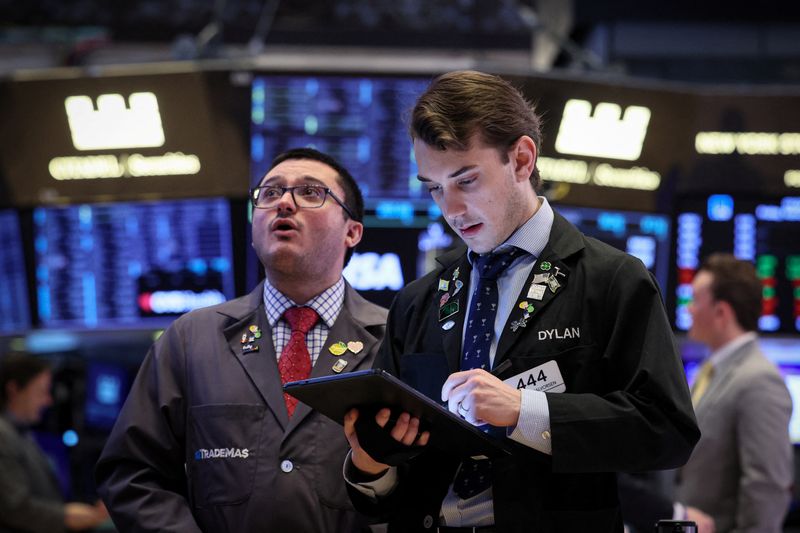Street Calls of the Week
Investing.com - U.S. stock futures tick higher, as investors assessed comments from a member of President Donald Trump’s cabinet around a possible softening in U.S. tariffs on Canada and Mexico. In the wake of a sell-off on Wall Street after the levies took effect on Tuesday, Commerce Secretary Howard Lutnick suggested that Trump could meet the two countries "in the middle" on a compromise.
1. Futures higher
U.S. stock futures pointed higher on Wednesday, as investors eyed comments from a top Trump administration figure around potentially scaling back recently-imposed tariffs on Canada and Mexico.
By 03:49 ET (08:49 GMT), the Dow futures contract had added 248 points or 0.6%, S&P 500 futures had climbed by 39 points or 0.7%, and Nasdaq 100 futures had climbed by 168 points or 0.8%.
The main averages on Wall Street sank on Tuesday, dented by ructions stemming from the U.S. levies on its northern and southern neighbors as well as a doubling of duties on China. All three of the countries have promised to respond to the tariffs, fueling concerns over an escalating global trade war.
At the end of the trading session, the benchmark S&P 500 had shed 1.2% and the 30-stock Dow Jones Industrial Average had dropped by 1.5%. The tech-heavy Nasdaq Composite dipped by 0.4%, hovering near correction territory.
Traditional American car manufacturers General Motors (NYSE:GM) and Ford (NYSE:F) fell by 4.6% and 2.9%, respectively. The firms have large supply chains that sweep across North America, which analysts have flagged could leave the businesses potentially exposed to the impact of the tariffs.
2. Trump addresses Congress
President Trump used an address to Congress on Tuesday to tout his rapid-fire policy actions during the opening months of his second term in office.
Stating that "America is back," Trump listed his moves to overhaul the country’s trading stance, reshape its foreign policy relationships and slash the size of its federal government through the Elon Musk-led Department of Government Efficiency.
The 100-minute, primetime speech -- which featured jeers from the president’s Democratic opponents -- came after Trump slapped 25% tariffs on Mexican imports and non-energy goods from Canada, threatening to upend a deeply-integrated North American economy. U.S. duties on Chinese imports were also doubled to 20%.
Economists and company executives have warned that the measures will drive up price pressures and delay a longstanding fight to quell relatively elevated inflation. Trump acknowledged that the levies will cause a "disturbance" in the short-term, but added that "we’re OK with that."
3. Lutnick on tariffs
Trump, however, is still tipped to "probably" announce a compromise deal with Canada and Mexico on the tariffs soon, according to Commerce Secretary Howard Lutnick.
Speaking to the Fox Business television channel, Lutnick noted that the potential agreement could involve ratcheting down some of Trump’s levies, which the president put in place in response to a perceived lack of action by the countries to prevent the flow into the U.S. of migrants and the illegal drug fentanyl.
Lutnick said the new compromises could be unveiled as soon as Wednesday, noting that Trump was ready to meet America’s long-time trading partners "in the middle."
Canada and Mexico had earlier received a 30-day reprieve from the tariffs in February after vowing to increase border security, but the deadline expired shortly after midnight on Tuesday after Trump indicated that neither country had done enough to meet his demands.
4. ISM services PMI ahead
On the economic calendar, investors will likely be keeping close tabs on fresh data on activity in the all-important U.S. services sector, especially after recent figures have suggested that American households and businesses are bracing for the effect of Trump’s tariffs.
Economists expect the Institute for Supply Management’s non-manufacturing PMI index to show that the segment, which accounts for a large bulk of the American economy, eased slightly in February.
Earlier this week, an ISM metric tracking the manufacturing industry cooled, but remained just above the 50-point level denoting expansion. However, a separate gauge of factory gate prices surged to a three-year peak and new orders slumped, as firms expressed worries over an uncertain operating environment stemming from the tariffs.
The numbers were on the heels of tepid consumer spending, an uptick in the goods trade deficit and weak homebuilding in January -- all of which have raised concerns over possible sluggishness in the U.S. economy in the first quarter.
5. Bitcoin rises
Bitcoin rose on Wednesday as an extended rout in crypto prices drew in some bargain buying, while hopes of a scaling down in Trump’s trade tariffs also aided risk appetite.
The world’s largest digital token was nursing wild swings over the past week, with its price temporarily falling below $80,000 amid the persistent fears over trade tariffs.
A recent announcement from Trump that five cryptocurrencies, including Bitcoin, would be included in a planned strategic crypto reserve, had sparked a short-lived rebound earlier this week.
Elsewhere, oil prices fell slightly Wednesday, trading around five-month lows as traders digested plans by major producers to raise output in April as well as the prospect of a widespread trade conflict.
